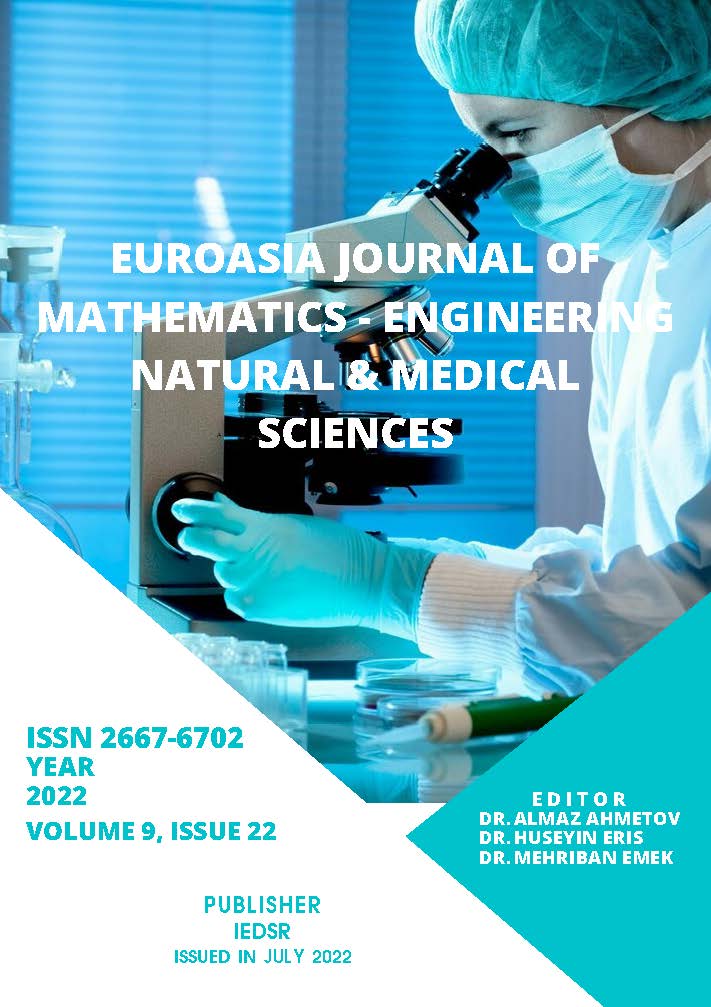The Effect of the Microwave Method on the Surface-Pore Structure of Activated Carbon Produced From Waste Biomass (Hot Red Pepper Stalks)
DOI:
https://doi.org/10.5281/zenodo.6948282Keywords:
Waste biomass, Isot pepper stalks, Microwave furnace, Active carbonAbstract
Activated carbon has been proven by many studies that it is an adsorbent material that is widely used in the removal of environmental pollutants by the adsorption process. In recent years, activated carbon production using waste biomass resources has been preferred due to its advantages such as waste disposal and obtaining high porous, cheap adsorbent. Waste biomass is the result of the use and processing of agricultural products, which are abundant in nature. In Turkey, hot red pepper (Capsicum annuum L.), which is widely used in spice production, is one of these agricultural products and most of the peppers produced are grown in the southeast region. The most important pepper of this region is isot grown in Şanlıurfa and documented by geographical indication regulations. Within the scope of this study, activated carbon was produced from isot stalks by two different methods. In the first method, isot stalks were impregnated with 100% ZnCl2 (zinc chloride), H3BO3 (boric acid) and H3PO4 (phosphoric acid) chemicals for 24 hours. In the second method, isot stalks with 100% H3PO4 (phosphoric acid) chemical were impregnated in a microwave oven at 500 W wave power for 15 minutes in a CO2 gas environment. Then, isot stalks were carbonized in a muffle furnace (650 ºC, 30 min). The characterization of activated carbons obtained by two different methods was performed by using BET for the determination of surface area and pore sizes, FT-IR for the determination of functional groups in its structure and SEM for obtaining surface morphological images were performed. According to the results obtained, cheap and environmentally friendly adsorbents were produced from waste isot stalks, and both waste disposal was done and a product with high added value was obtained.
References
Baytar, O. Ş. (2018). Characterization of Microwave and Conventional Heating on the Pyrolysis of Pistachio Shells for the Adsorption of Methylene Blue and Iodine. Analytical Letters,, 51(14), 2205–2220. https://doi.org/10.1080/00032719.2017.1415920.
Chairunnisa, F. M. (2020). Enhancing water adsorption capacity of acorn nutshell based activated carbon for adsorption thermal energy storage applicatio. Energy Reports, Volume 6, Supplement 7, Pages 255-263, doi.org/10.1016/j.egyr.2020.11.038.
Dolas H, S. O. (2010). A New Method on Producing of Activated Carbon: The Effect of Salt on The Surface Area and The Pore Size Distribution of Activated Carbon Prepared Pistachio Shell. Chemical Engineering Journal, 166, 191-197, https://doi.org/10.1016/j.cej.2010.10.061.
Iván Costa-Trigo, A. P.-P. (2020). Detoxification of chestnut burrs hydrolyzates to produce biomolecules,. Biochemical Engineering Journal, Volume 159, 107599, doi.org/10.1016/j.bej.2020.107599.
J.Plank, B. J. (2010). Experimental determination of the thermodynamic parameters affecting the adsorption behaviour and dispersion effectiveness of PCE superplasticizers,. Cement and Concrete Research,, Volume 40, Issue 5, Pages 699-709. doi.org/10.1016/j.cemconres.2009.12.002.
Jean-François, B. A. (2008). On the protonation of oxo- and hydroxo-groups of the goethite (α-FeOOH) surface: A FTIR spectroscopic investigation of surface O–H stretching vibrations, . Geochimica et Cosmochimica Acta, Volume 72, Issues 14, Pages 3338-3357, doi.org/10.1016/j.gca.2008.04.022.
Khaled Zoroufchi Benis, A. S. (2022). A binary oxide-biochar composite for adsorption of arsenic from aqueous solutions: Combined microwave pyrolysis and electrochemical modification,. Chemical Engineering journal, Volume 446, Part 2, 137024, doi.org/10.1016/j.cej.2022.137024.
Korkmaz, A. H. (2017). Evaluation of the volatile compounds of fresh ripened Capsicum annuum and its spice pepper (dried red pepper flakes and isot). LWT, 84, 842–850. https://doi.org/10.1016/j.lwt.2017.06.058.
Ositadinma Chamberlain Iheanacho, J. T. (2021). Packed bed column adsorption of phenol onto corn cob activated carbon: linear and nonlinear kinetics modeling,. South African Journal of Chemical Engineering, Volume 36, Pages 80-93. doi.org/10.1016/j.sajce.2021.02.003.
Sandro Altenor, B. C.-J. (2009). Adsorption studies of methylene blue and phenol onto vetiver roots activated carbon prepared by chemical activation,. Journal of Hazardous Materials, Volume 165, Issues 1-3, Pages 1029-1039, doi.org/10.1016/j.jhazmat.2008.10.133.
Shuang Zhang, Y. M. (2022). Clean production of N, O-doped activated carbon by water vapor carbonization/activation of expired coffee for high-volumetric supercapacitor, . Applied Surface Science , Volume 589,Pages 153011, doi.org/10.1016/j.apsusc.2022.153011.
Wahyu Widanarto, S. I. (2022). Improved microwave absorption traits of coconut shells-derived activated carbon, . Diamond and Related Materials, Volume 126,109059, doi.org/10.1016/j.diamond.2022.109059.
Zha Wei, L. B. (2022). Construction of Pingdingshan coal molecular model based on FT-IR and 13C-NMR,. Journal of Molecular Structure, Volume 1262, Pages 132992, doi.org/10.1016/j.molstruc.2022.132992.
Zhuanglei Zou, M. Y. (2015). Airflow resistance and bio-filtering performance of carbon nanotube filters and current facepiece respirators,. Journal of Aerosol Science, Volume 79, Pages 61-71, doi.org/10.1016/j.jaerosci.2014.10.003.
Downloads
Published
How to Cite
Issue
Section
License
Copyright (c) 2022 Euroasia Journal of Mathematics, Engineering, Natural & Medical Sciences

This work is licensed under a Creative Commons Attribution-NonCommercial 4.0 International License.

